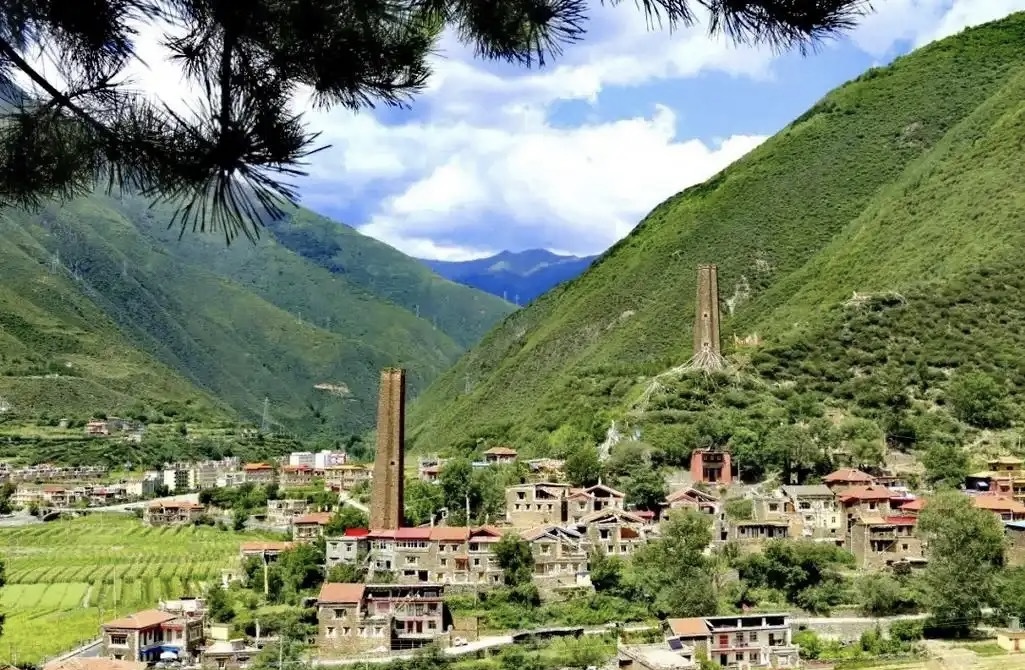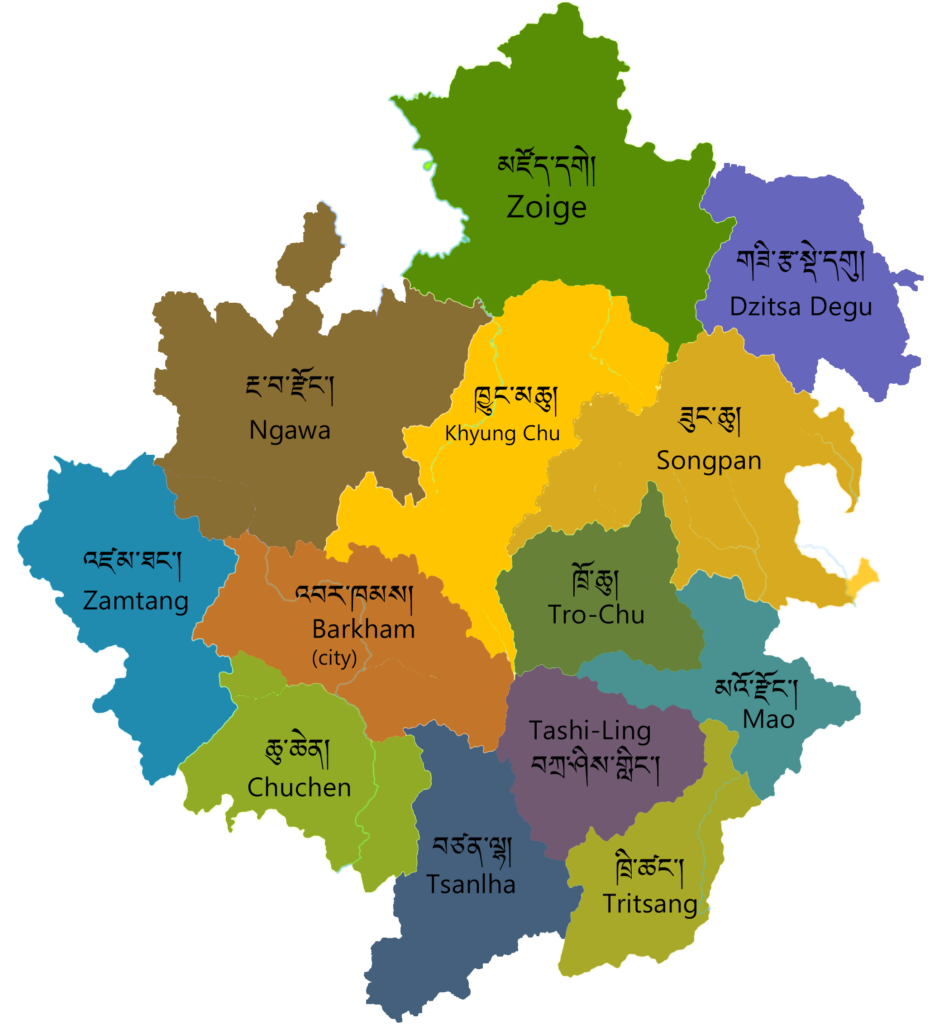
Barkam (also known as Ma’erkang, 马尔康, Mǎ’ěrkāng in Mandarin) is the capital of Ngawa (Aba) Tibetan and Qiang Autonomous Prefecture in Sichuan Province. Located in the heart of the Gyalrong Tibetan region, Barkam is known for its unique Gyalrong Tibetan culture, traditional architecture, and scenic landscapes. The town serves as a gateway to surrounding Tibetan villages and offers a glimpse into the distinct heritage of the Gyalrong Tibetans, who are known for their rich cultural traditions and ancient fortress-style architecture.

Zhuokeji Tibetan Village
Located near Barkam, Zhuokeji Village (卓克基藏寨) is one of the most well-preserved Gyalrong Tibetan villages, famous for its traditional stone fortress-like architecture.
The village is home to Zhuokeji Chieftain’s Manor, a multi-story stone fortress built in the 18th century. This historical site provides insight into the social structure and daily life of the Gyalrong Tibetans. Visitors can explore the manor, learn about local legends, and enjoy stunning views of the surrounding valley and mountains. The fortress’s architecture, featuring tall stone walls, narrow passages, and wooden balconies, reflects the defensive style once common in the area.
Suopo Thousand-House Village
Also known as “the kingdom of thousand stone houses,” Suopo Village (梭坡千户藏寨) is a cluster of ancient stone homes that rise on a hill in a fortress-like arrangement, showing the distinct architecture of the Gyalrong Tibetans.
The village consists of dozens of stone towers and tall stone houses that resemble ancient castles. This unique architectural style reflects the defensive strategies of the past and the self-sustaining nature of the Gyalrong communities. Walking through Suopo Village offers visitors an immersive experience of traditional Tibetan life and architecture, with beautiful views of the Dadu River Valley.
Songgang Tibetan Village
Songgang Village (松岗藏寨) is another historically significant Gyalrong Tibetan village, known for its traditional watchtowers and fortress-style buildings.
The village is dotted with well-preserved watchtowers, some of which are hundreds of years old, adding a medieval atmosphere to the landscape. These towers, reaching heights of up to 30 meters, were historically used for communication and protection. The Gyalrong people in Songgang also maintain their traditional customs, and visitors can enjoy the opportunity to see unique Tibetan cultural practices, arts, and handicrafts.
Barkam Town
The town of Barkam itself is a blend of traditional Tibetan architecture and modern Chinese influences. It serves as the administrative center of Ngawa Prefecture and a hub for travelers exploring the Gyalrong Tibetan region.
In Barkam, you can explore Tibetan Buddhist temples, try local Tibetan food, and shop for traditional Tibetan crafts. The town is known for its colorful buildings and scenic location along the Minjiang River. Barkam’s streets often come alive with Tibetan festivities, especially during Tibetan New Year (Losar) and other local festivals.
Gyalrong Tibetan Culture and Festivals
he Gyalrong Tibetans in Barkam have a unique culture that sets them apart from other Tibetan groups, especially in terms of language, clothing, and religious practices.
The Gyalrong celebrate Tibetan festivals with their own distinctive traditions. During festivals like Losar, locals dress in ornate, colorful Gyalrong Tibetan attire and hold ceremonial gatherings and dances. Gyalrong Tibetans are known for their skilled craftsmanship, particularly in woodcarving and weaving. Visitors during festivals will see traditional cham dances, processions, and offerings, which are both spiritual and vibrant expressions of Gyalrong heritage.
Scenic Landscapes
Barkam is set amid rolling hills, valleys, and rivers, offering beautiful scenery typical of the Tibetan Plateau. The area around Barkam is known for its green hillsides, wildflowers, and pristine streams.
The landscape varies dramatically with the seasons. Spring brings wildflowers, while autumn covers the hillsides in vibrant gold and red foliage. There are opportunities for hiking, photography, and exploring remote Tibetan villages nestled in scenic valleys. The nearby Dadu River Valley and Minjiang River Valley offer excellent spots for nature walks and picnics.
Administrative Divisions of Ngawa Tibetan and Qiang Autonomous Prefecture

| Serial No | Name of Counties | Name in Tibetan | Area (km2) |
| 1 | Maerkang (Barkham) | འབར་ཁམས་གྲོང་ཁྱེར། | 6639 |
| 2 | Wenchuan (Longgu) | ལུང་དགུ་རྫོང་། / ཁྲི་ཚང་རྫོང་། | 4083 |
| 3 | Li xian (Tashi Ling) | བཀྲ་ཤིས་གླིང་། | 4318 |
| 4 | Mao xian (Maodzong) | མའོ་ཝུན། | 4075 |
| 5 | Songpan (Songchu) | ཟུང་ཆུ་རྫོང་། | 8486 |
| 6 | Jiuzhaigou (Dzitsa Degu) | གཟི་རྩ་སྡེ་དགུ་རྫོང་། | 5286 |
| 7 | Jinchuan (Chuchen) | ཆུ་ཆེན་རྫོང་། | 5524 |
| 8 | Xiaojin (Tsanlha) | བཙན་ལྷ་རྫོང་། | 5571 |
| 9 | Heishui (Trochu) | ཁྲོ་ཆུ་རྫོང་། | 4154 |
| 10 | Rangtang (Dzamtang) | འཛམ་ཐང་རྫོང་། | 6836 |
| 11 | Aba (Ngawa) | རྔ་བ་རྫོང་། | 10435 |
| 12 | Ruoergai (Zoige) | མཛོད་དགེ་རྫོང་། | 10437 |
| 13 | Hongyuan (Khyungchu) | རྐ་ཁོག་རྫོང་། / ཁྱུང་མཆུ་རྫོང་། | 8398 |
Travel Tips for Visiting Barkam
- Best Time to Visit: The best times to visit Barkam are from May to October. Spring and autumn are especially beautiful with mild weather and colorful scenery. The region can be very cold in winter, with snow covering some higher-altitude areas.
- Altitude Considerations: Barkam sits at around 2,600 meters (8,530 feet) above sea level. While it’s lower than some other Tibetan Plateau regions, altitude sickness can still be an issue for some travelers. Gradual acclimatization, staying hydrated, and avoiding strenuous activities at first can help.
- Local Customs: Barkam and its surrounding villages are deeply traditional. Respect for local customs is essential, especially in monasteries and religious sites. Dress modestly, avoid photographing people without permission, and observe Buddhist practices respectfully.
- Accommodations: Barkam offers a variety of accommodations, from budget guesthouses to mid-range hotels. Some traditional homestays are available in nearby villages, offering a more immersive cultural experience.
- Transportation: Getting to Barkam can be challenging as the area is remote. Most visitors travel via road from Chengdu or other towns in Sichuan, which can take several hours but offers scenic views along the way. A private car or a guided tour is recommended for easier access to surrounding villages.
Barkam provides a unique opportunity to experience Tibetan culture and traditions specific to the Gyalrong Tibetan people. Its scenic beauty, ancient villages, and spiritual ambiance make it a captivating destination for those interested in Tibetan heritage and the natural landscapes of Sichuan.
 Tibet World Travel Tibet Tour, Tibet Trip, Tibet Travel, Tibet Train, Tibet Trekking,
Tibet World Travel Tibet Tour, Tibet Trip, Tibet Travel, Tibet Train, Tibet Trekking,
